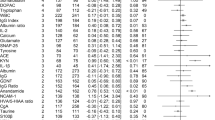Abstract
Irvine1 and Hoffer and Mahon2 reported on the occurrence of a compound giving a characteristic mauve colour with Ehrlich's reagent on paper. The significance of this metabolite is that it occurs with greater frequency in psychotic individuals. This finding has been confirmed by several investigators3–5. Ellman et al.6, however, reported that a metabolite apparently identical to the one in question may be derived from phenothiazines and occurs in the urine of patients on phenothiazine therapy. Recently, Irvine7 has identified the mauve factor as 2,4-dimethyl-3-ethylpyrrole on the basis of chromatographic and mass spectral studies. This report is concerned with the identity of the mauve factor, a critique of various isolation procedures used by different investigators and its pharmacological action on the central nervous system (CNS). The possible CNS effect is important because several laboratories have postulated a metabolic product in the schizophrenic which may be stimulant and hallucinogenic.
This is a preview of subscription content, access via your institution
Access options
Subscribe to this journal
Receive 51 print issues and online access
$199.00 per year
only $3.90 per issue
Buy this article
- Purchase on Springer Link
- Instant access to full article PDF
Prices may be subject to local taxes which are calculated during checkout
Similar content being viewed by others
References
Irvine, D. G., J. Neuropsychiat., 2, 292 (1961).
Hoffer, A., and Mahon, M., J. Neuropsychiat., 2, 331 (1961).
Sohler, A., Renz, R. H., Smith, S., and Kaufman, jun., J., Intern. J. Neuropsychiat., 3, 327 (1967).
O'Reilly, P. O., Ernest, M., and Hughes, G., Brit. J. Psychiat., 111, 741 (1965).
O'Reilly, P. O., Hughes, G., Russell, S., and Ernest, M., Dis. Nerv. Syst., 26, 562 (1965).
Ellman, G. L., Jones, R. T., and Rychert, R. C., Amer. J. Psychiat., 125, 849 (1968).
Irvine, D. G., Bayne, W., Miyashita, H., and Majer, J. R., Nature, 224, 811 (1969).
Forrest, F. M., Forrest, I. S., and Mason, A. S., Amer. J. Psychiat., 118, 300 (1961).
Goldstein, L., and Beck, R. A., in Internat. Rev. Neurobiol. (edit. by Pfeiffer, C. C., and Smythies, J. R.), 8, 266 (1965).
Author information
Authors and Affiliations
Rights and permissions
About this article
Cite this article
SOHLER, A., BECK, R. & NOVAL, J. Mauve Factor re-identified as 2,4-Dimethyl-3-ethylpyrrole and its Sedative Effect on the CNS. Nature 228, 1318–1320 (1970). https://doi.org/10.1038/2281318a0
Received:
Revised:
Issue Date:
DOI: https://doi.org/10.1038/2281318a0
This article is cited by
-
Die (Krypto-)Pyrrolurie in der Umweltmedizin: eine valide Diagnose?
Bundesgesundheitsblatt - Gesundheitsforschung - Gesundheitsschutz (2007)
-
?-Aminolaevulinic acid and amino acid neurotransmitters
Molecular and Cellular Biochemistry (1981)
-
The ‘mauve factor’ of schizophrenia and porphyria, 5-hydroxyhaemopyrrole lactam, has low pharmacological potency on guinea-pig ileum
Experientia (1979)
Comments
By submitting a comment you agree to abide by our Terms and Community Guidelines. If you find something abusive or that does not comply with our terms or guidelines please flag it as inappropriate.



